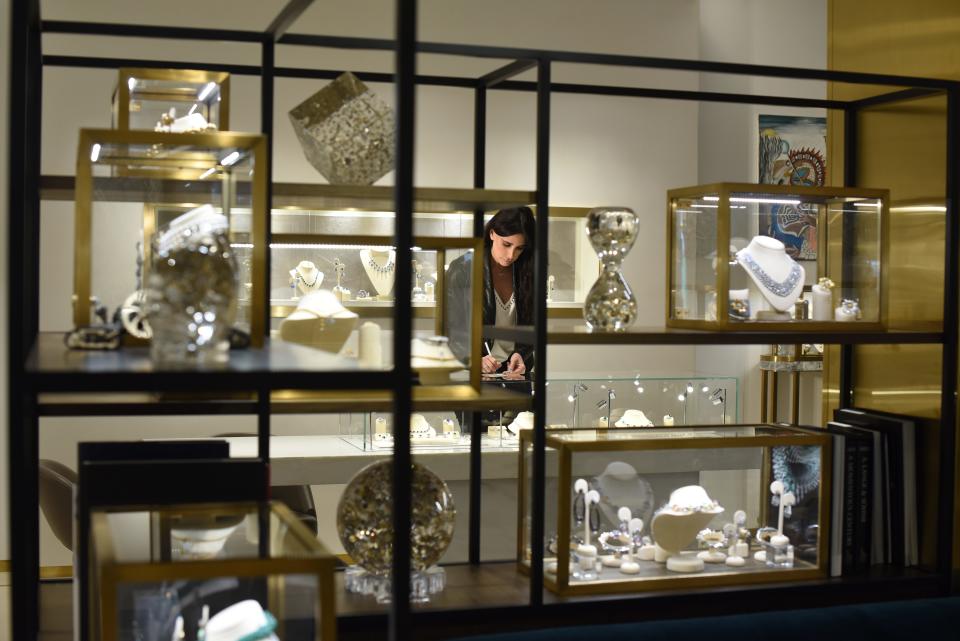Fake diamond alert: If yours are simulated or made in a lab, you can't call them mined
Not all diamond sellers have sparkling reputations.
The Federal Trade Commission is ticked off at jewelers who are calling their glittery wares “eco-friendly” and “sustainable” and misrepresenting simulated diamonds as lab-created or mined ones or lab-created diamonds as mined stones.
Wedding season is soon upon us, and with that, lots and lots of diamonds. That means it's important to understand that buying diamonds is no longer as simple as the Four Cs – carat, cut, color and clarity. Now, it's Mother Nature versus science and marketing.
Mined diamonds are the traditional stones dug out of the ground, while lab-created diamonds have the same chemical and physical attributes as mined diamonds but are made in a laboratory using carbon, heat and pressure, according to FTC attorney Robert Frisby. Simulated diamonds might resemble traditional diamonds in some ways, like appearance, but are not chemically the same and may not be as hard or as durable.

Attention, pet owners: Petco offering a free upgrade to artificial-free pet food with May 18-19 trade-in events
Where do you live? Homes for sale: Here are the most affordable ZIP codes in the US
Old-school diamonds are the most expensive of the three categories, and that's where the glitter of marketing comes in. A dishonest jeweler may present the other types as mined and charge more, but unlike other fakes – like a Chanel purse with entwined Cs that actually are Gs – the distinction can rarely be detected by the naked eye.
"It's very difficult for a layperson to distinguish between lab-grown and mined," Frisby said. "Simulated ... may depend on the type of simulate it is. Some are tougher than others."
In warning letters the FTC sent last month, eight jewelry marketers were told not to use the word "diamond" to describe a simulated or lab-created stone "unless that word is immediately proceeded by a clear and conspicuous disclosure that the product is not a mined stone," the FTC said. The rule also applies to other precious stones, like emeralds and rubies, and pearls.
Some jewelry buyers specifically want lab-created or simulated diamonds, due to concerns that mining can damage the environment and the risks of what are called blood diamonds – stones originating from war-torn areas, where the mines finance the conflicts and may utilize slave or child labor. Lab-created and simulated diamonds' lower prices also make them attractive to certain shoppers.
The impact diamond mining may have on the environment is what prompts some disreputable jewelry vendors to use advertise their non-mined merchandise as "eco-friendly," "eco-conscious" or "sustainable." The FTC said it's highly unlikely that companies making those claims can substantiate them.
"You have to have a reasonable basis for whatever claim the advertiser is making," Frisby said.
The Diamond Producers Association, whose members include De Beers, said in a statement that it "welcomes the FTC’s warning to synthetic diamond manufacturers against misleading consumers with their marketing tactics. This warning is an important step toward transparency and consumer protection."
Michael Lewyn didn’t think to ask about what kind of diamonds he was looking at when he went shopping for an engagement ring in the winter. "Mined" had no meaning to the 55-year-old Manhattanite.
“I don’t even think I knew that word,” he said. “All I knew was she said, ‘Get a diamond,’ and I get a diamond.”
Lewyn checked out a couple of national jewelry store chains whose ads he vaguely recalled and then walked through New York City’s famous Diamond District. He snapped photos as he went, which he sent to his fiancée, Helen Teitelbaum. The stores that sold some of the rings she liked he then looked up on Yelp to check their online reviews. The end result was a $2,000 solitaire ring, a bit less than one carat, that Lewyn presented to her in front of the New York Public Library.
“If you’re looking for more of an investment, you probably want a higher level of scrutiny and probably want to spend more time researching about diamonds,” Lewyn said. “I read a little, but to me, it was not too interesting.”
To Leon Adams, owner of Cellini Jewelers in Midtown Manhattan, stories about precious-stone cons are upsetting. He occasionally sees them first-hand when someone brings in a piece of jewelry purchased elsewhere to examine, like the woman who paid more than $30,000 for a pair of ruby earrings only to have him inform her that they were synthetic gems.
"It obviously gives the entire industry a bad reputation," he said. "With today's technology, it's really become somewhat of a problem for the industry and consumers."
![May 16, 2019, New York, NY. Marcelle Harari shows a selection of diamonds at Cellini Jewelers, owned by Leon Adams, in Midtown Manhattan, NY. The FTC is ticked off at jewelers who are presenting their glittery wares as “eco-friendly” or “sustainable” and misrepresenting simulated diamonds as lab-created or mined ones or lab-created diamonds as mined ones. 5/16/2019, Photo by Jennifer S. Altman, Freelance ORG XMIT: JA 138027 fake sustainable 05/17/2018 [Via MerlinFTP Drop]](https://s.yimg.com/ny/api/res/1.2/jcQHelbFQ1tMnV62Vh1I2w--/YXBwaWQ9aGlnaGxhbmRlcjt3PTk2MDtoPTY0MQ--/https://media.zenfs.com/en-US/homerun/usa_today_money_325/47db6ec1074034feaad41e1b8a91438e)
That diamonds are such large-ticket items makes the scams all the more upsetting to victims. Adams advises buying only from jewelers who've been in business for a while and who have a return policy, paying with a credit card in case you have a dispute and avoiding making purchases online where you can't physically examine it.
"You would have to have some training in gemology to loupe the stone to see the internal structure to determine if it's naturally occurring," he said, explaining how a scam is uncovered. "In the best-case scenario, we’re talking thousands of dollars at a minimum."
Follow USA TODAY reporter Zlati Meyer on Twitter: @ZlatiMeyer
This article originally appeared on USA TODAY: Fake diamond alert: If yours are simulated or made in a lab, you can't call them mined
